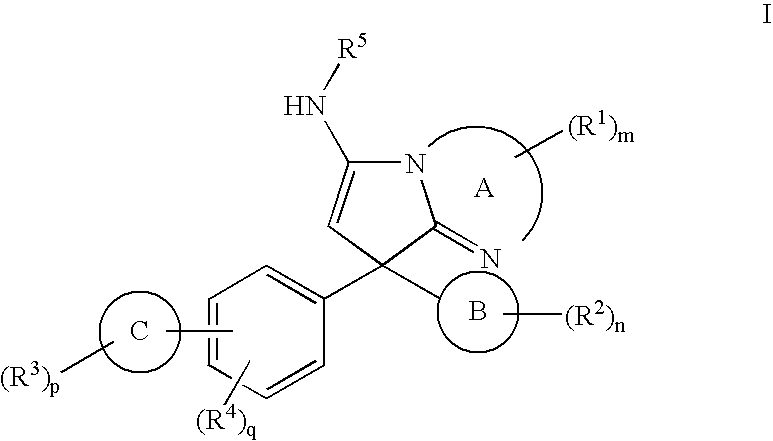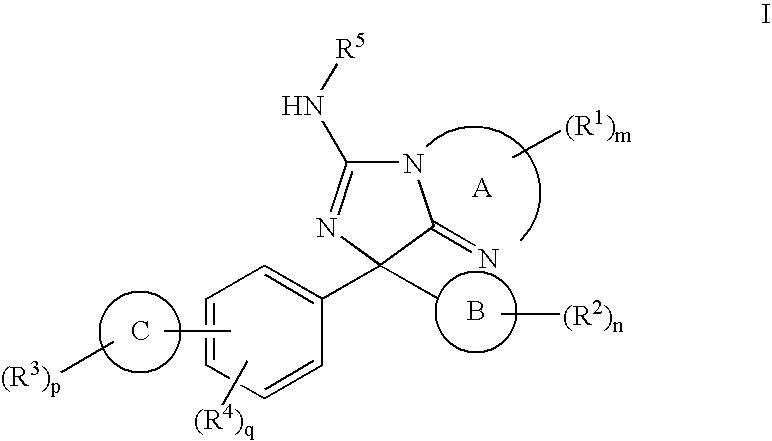New Compounds 319
- Summary
- Abstract
- Description
- Claims
- Application Information
AI Technical Summary
Benefits of technology
Problems solved by technology
Method used
Image
Examples
example 1
4-Bromo-1-fluoro-2-methoxybenzene
[0181]
[0182] Aqueous hydrobromic acid (48%, 2.41 mL) was added to 4-fluoro-3-methoxyaniline (1.0 g, 7.1 mmol) in water (10 mL) and the resulting mixture was cooled to 0° C. in an ice bath. A solution of sodium nitrite (538 mg, 7.8 mmol) in water (5 mL) was added drop wise during 15 min while maintaining the temperature between 0 and 5° C. The resulting diazoniumsalt solution was added to a suspension of copper(I) bromide (1.12 g, 7.8 mmol) in water (5 mL) which had been pre-heated to 75° C. The mixture was shaken thoroughly, aqueous hydrobromic acid (48%, 12.07 mL) was added and the solution was stirred at ambient temperature for 16 h. Excess water was added and the product was extracted with diethyl ether and the combined organic extracts were washed with aqueous saturated sodium chloride, dried over magnesium sulfate, filtered and the solvent was evaporated in vacuo to give 1.02 g (70% yield) of the title compound: 1H-NMR (DMSO-d6): δ 7.36 (dd, J=...
example 2
2-(4-Fluoro-3-methoxyphenyl)-4,4,5,5-tetramethyl-1,3,2-dioxaborolane
[0183]
[0184] Anhydrous 1,2-dimethoxyethane (12 mL) was added to 4-bromo-1-fluoro-2-methoxybenzene (1.02 g, 5.0 mmol), tris(dibenzylideneaceton)dipalladium (0) (228 mg, 0.25 mmol), tricyclohexylphosphine (209 mg, 0.75 mmol), potassium acetate (732 mg, 7.5 mmol) and 4,4,4′,4′,5,5,5′,5′-octamethyl-2,2′-bi-1,3,2-dioxaborolane (1.14 g, 4.5 mmol) and the resulting mixture was irradiated in a microwave at 150° C. for 1 h. When cooled to ambient temperature the mixture was filtered and the solvent was evaporated in vacuo to give the crude product: MS (EI) m / z 252 [M+●].
example 3
3-Methoxy-5-(4,4,5,5-tetramethyl-1,3,2-dioxaborolan-2-yl)phenol
[0185]
[0186] The title compound was synthesized as described for example 2 in 48% yield starting from 3-chloro-5-methoxyphenol. Purified by column chromatography, using a gradient of dichloromethane / acetonitrile (100 / 0 to 90 / 10) as the eluent: 1H-NMR (DMSO-d6): δ 9.36 (s, 1H), 6.69 (d, J=2.3 Hz, 1H), 6.61 (d, J=2.0 Hz, 1H), 6.41 (t, J=2.4 Hz, 1H), 3.69 (s, 3H), 1.27 (s, 12H); MS (ES) m / z 251 [M+1]+.
PUM
| Property | Measurement | Unit |
|---|---|---|
| Volume | aaaaa | aaaaa |
| Mass | aaaaa | aaaaa |
| Mass | aaaaa | aaaaa |
Abstract
Description
Claims
Application Information
 Login to View More
Login to View More - R&D
- Intellectual Property
- Life Sciences
- Materials
- Tech Scout
- Unparalleled Data Quality
- Higher Quality Content
- 60% Fewer Hallucinations
Browse by: Latest US Patents, China's latest patents, Technical Efficacy Thesaurus, Application Domain, Technology Topic, Popular Technical Reports.
© 2025 PatSnap. All rights reserved.Legal|Privacy policy|Modern Slavery Act Transparency Statement|Sitemap|About US| Contact US: help@patsnap.com



